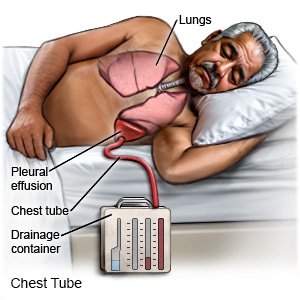Pleural Empyema
Medically reviewed by Drugs.com. Last updated on Aug 4, 2025.
Pleural empyema is pus-filled fluid in the pleural space due to infection. The pleural space is between your lungs and the inside of your chest cavity. Pleural empyema is usually caused by pneumonia. A plural empyema can become a medical emergency that needs immediate treatment.
WHILE YOU ARE HERE:
Informed consent
is a legal document that explains the tests, treatments, or procedures that you may need. Informed consent means you understand what will be done and can make decisions about what you want. You give your permission when you sign the consent form. You can have someone sign this form for you if you are not able to sign it. You have the right to understand your medical care in words you know. Before you sign the consent form, understand the risks and benefits of what will be done. Make sure all your questions are answered.
A pulse oximeter
is a device that measures the amount of oxygen in your blood. A cord with a clip or sticky strip is placed on your finger, ear, or toe. The other end of the cord is hooked to a machine.
Medicines:
Antibiotics are usually given to treat a bacterial infection. This medicine is given to treat pneumonia. You may not get antibiotics if your empyema is not caused by pneumonia.
Related medications
Tests:
- Blood tests are used to find the bacteria or fungi causing your empyema. Blood tests may also show if the infection has spread to your blood or you have signs of inflammation.
- X-ray or CT scan pictures are used to find signs of pneumonia or a lung abscess. The pictures may also show fluid buildup in your lungs.
- Thoracentesis is a procedure used to remove a fluid sample from the pleural space. The sample is tested for the bacteria or fungi causing your empyema.
Treatment:
- A drain or chest tube may be placed to remove fluid from the pleural space.

- Thoracotomy is a procedure used to drain fluid from around your lungs and clean out pus and any scarring. Ask your healthcare provider for more information on this procedure.
- A ventilator is a machine that gives you oxygen and breathes for you when you cannot breathe well on your own. An endotracheal (ET) tube is put into your mouth or nose and attached to the ventilator. You may need a trach if an ET tube cannot be placed. A trach is a tube put through an incision and into your windpipe.
- Surgery may be used to help your lungs expand more easily and fully.
RISKS:
You may have permanent lung damage, even after treatment. Empyema may become severe if it is not treated quickly. The inflammation may cause scarring in the pleural space. This can create small pockets of infection that are difficult to drain. Fluid buildup can make it difficult for your heart to pump correctly. This can cause an enlarged heart or heart failure.
CARE AGREEMENT:
You have the right to help plan your care. Learn about your health condition and how it may be treated. Discuss treatment options with your healthcare providers to decide what care you want to receive. You always have the right to refuse treatment.© Copyright Merative 2025 Information is for End User's use only and may not be sold, redistributed or otherwise used for commercial purposes.
The above information is an educational aid only. It is not intended as medical advice for individual conditions or treatments. Talk to your doctor, nurse or pharmacist before following any medical regimen to see if it is safe and effective for you.
Further information
Always consult your healthcare provider to ensure the information displayed on this page applies to your personal circumstances.
